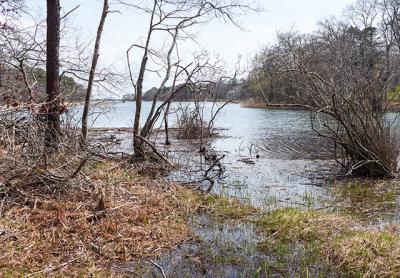Waterways Study a Mixed Report

East Hampton has some of the most beautiful and bountiful water bodies on Long Island, and government’s growing attention to water quality remediation is encouraging, but harmful algal blooms continue to foul several waterways due to excessive nitrogen and phosphorus, largely fed by aging or failing septic systems. That was the message Christopher Gobler of Stony Brook University’s School of Marine and Atmospheric Sciences delivered on Monday in his annual report to the East Hampton Town Trustees.
The good news, he told the trustees, is that his data suggest that some waterways in which the State Department of Environmental Conservation has prohibited shellfish harvesting could be opened, either seasonally or year round. The bad news is that Three Mile Harbor has had the highest levels of rust tide ever seen here.
Dr. Gobler has monitored waterways under the trustees’ jurisdiction for the past several years. He also studies Georgica Pond on behalf of an association of property owners. His assessment was mostly upbeat, pointing to mitigation measures that appear to be helping Georgica Pond and to Suffolk County’s 2016 approval of improved septic systems that will significantly reduce the amount of nitrogen released.
Alexandrium, which produces a toxin that causes paralytic shellfish poisoning, was first documented on Long Island in 2006 and has been seen at varying levels every year since then, Dr. Gobler said. Cyanobacteria, the blue-green algae that have afflicted Georgica Pond and several other water bodies, appeared here in 2003. Cochlodinium, or rust tide, has recurred annually since its appearance in 2004.
“More nitrogen going from land to sea now, because there’s more people and more activity on land than there had been in the past” is the primary cause, the scientist said. Nitrogen not only makes the algae grow faster, but “the organism can make more of the toxin because it has more nitrogen.”
In 2016, alexandrium was measured only in Three Mile Harbor, and only at low levels, he said. However, maximum levels of cochlodinium, or rust tide, “were extremely high,” in Three Mile Harbor, with one event possibly the densest bloom ever seen in East Hampton Town waters. The 2016 levels “were much higher than in 2015, and also significantly higher than the long-term average.” Dinophysis, or red tide, was also found in the harbor.
But even Three Mile Harbor presented a reason for optimism, he said. Most of the groundwater in the Three Mile Harbor watershed moves relatively quickly, he said. “If you make the changes now, “within 10 years you will have addressed at least 64 percent of your groundwater entering the water body,” he said. The vote in November approving up to 20 percent of community preservation fund proceeds to be used for water quality initiatives demonstrates a determination to take action, he said. In East Hampton, “Three Mile Harbor is obviously an area to be focused on.”
That focus coincides with Suffolk County’s Reclaim Our Waters program, through which advanced septic systems have been approved. Dr. Gobler referred to a “10-10-30” goal: septic systems that release less than 10 milligrams of nitrogen per liter, costing less than $10,000, and having a minimum 30-year lifespan. Nitrogen-removing biofilters, which work with existing septic systems, are another promising technology, he said.
In Georgica Pond, cyanobacteria levels were much lower in 2016 than in the two previous years, and Dr. Gobler said the removal last summer of nearly 60,000 pounds of macroalgae from the pond with an aquatic weed harvester may be responsible. By removing macroalgae, he said, “you’re taking nitrogen and phosphorus out of the pond.” The effort will be repeated this year.
“Over all, I think the town board is doing great work using C.P.F. money to focus on the septics that are close to water bodies. . . . It seems like we’re making some good headway on that front,” Tyler Armstrong, a trustee, said at the presentation’s conclusion.
“Our job,” Mr. Armstrong continued, “seems to be to use whatever techniques we can to mitigate the onset of blooms, and the effects of blooms, in our water bodies as we replace septic systems, work on reducing input to surface water from groundwater, and, hopefully, work together to eventually get this under control within 10 years. . . . I have a lot of confidence from your report.”
In other news, Mr. Armstrong reported that the two pump-out boats operated by the trustees, in Three Mile Harbor and Lake Montauk, removed 93,380 gallons of sewage from 2,530 boats in 2016. A $10,000 grant from the State Environmental Facilities Corporation offset the cost of the boats.
